Diabetes mellitus is a common metabolic disorder which affects all the vital systems of the body including eyes, kidneys, heart, nerves and blood vessels etc., [1]. The prevalence of diabetes is increasing mostly in the world’s middle income countries and India is going to become the diabetic capital of the world by 2030 [2]. Diabetes mellitus affects more than 422 million adults globally and it is raising from 4.7% to 8.5% compared to 1980 [3]. Hyperglycaemia and its attendant metabolic complications lead to various biochemical changes leading to complications like nephropathy, retinopathy and peripheral neuropathy. Type II diabetes mellitus (Non insulin dependent diabetes mellitus) is treated mainly by oral antidiabetic drugs and gliptins which lead to various complications like hypoglycaemia, weight gain, water retention, diarrhoea, malabsorption, necrotising pancreatitis, etc., [1,4,5]. This leads to a search for newer antidiabetic drugs with least adverse effect from plant material.
With this background we conducted our study with the objectives of evaluating the antihyperglycaemic activity of Aqueous Extract of Solanum Nigrum Linn Berries (AESNB) in Alloxan induced Wistar albino rats.
Materials and Methods
An interventional study involving rats was done in Department of Pharmacology, Karpagam Faculty of Medical Sciences and Research, Coimbatore, India, during the period of September 2013 to October 2013 after obtaining clearance from Institutional Animal Ethical Committee (KFMSR/IAEC/004/2013).
Plant material: Berries of Solanum nigrum were collected from Tamil Nadu, India, during the month of September. All the berries were washed and dried in shade.
Extractions: The dried berries were coarsely powdered in a food processor. Aqueous extract was prepared by using Soxhlet apparatus. The aqueous extract of berries was kept in the desiccators to remove the remaining moisture. The solid residues were stored in the container and preserved at 40C in the refrigerator and the voucher number was given as KFMSR/Pharm/004.
Qualitative phytochemical analysis: The aqueous extract of berries was analysed for flavonoids, alkaloids, glycosides, saponins, tannins, proteins and amino acids, sterols, triterpenoids, carbohydrates, fixed oils, anthraquinones, resins and steroids [8,9].
Instruments and chemicals: Glucometer (Acucheck-Sensor) Mumbai, India) was used to measure the fasting blood glucose level {GOD–POD method (Glucose oxidase-peroxidase method)}. Glimepride was obtained from IPCA Laboratories, Mumbai, India. It was used as the standard drug in the dose of 0.1 mg/kg/day [7]. Alloxan monohydrate was purchased from Sigma chemicals, USA, and used to induce diabetes mellitus.
Animals: The Swiss Albino mice and Wistar Albino rats were procured from Central Animal House, Karpagam University, after getting the approval from Institutional Animal Ethical Committee. Five Swiss Albino mice of either sex weighing 20-30 gm were used for the acute toxicity study. Thirty Wistar Albino rats of male sex weighing 150-200 gm were used in this study to evaluate the antihyperglycaemic activity. Animals were housed into five groups of six animals each, at a temperature of 28±2°C, relative humidity of 55%–65% and dark: light cycle of 12:12 hour. Animals were allowed for free access to food, water and ad libidum. Animals were handled minimally with care.
Acute toxicity studies: Acute oral toxicity study was done according to the OECD 425 guidelines. Five Swiss Albino mice were used. All the animals were fasted prior to the experiment. First, one animal was administered single dose of 2000 mg/kg of AESNB by using a stomach tube and the animal was observed for changes in skin, fur, eyes and mucous membranes, respiratory, circulatory, autonomic functions, somatomotor activity and behavioural pattern. After 24 hours, the remaining four animals were given the test compound in the same dose and observed for 14 days. The doses of AESNB used in this study were calculated from the acute oral toxicity study [10].
Diabetes mellitus induction: After overnight fasting Type 2 diabetes was induced by single intraperitoneal injection of 120 mg/kg, b.w of Alloxan monohydrate dissolved in normal saline. After one hour of alloxan administration, the animals were fed on standard pellets and water ad libitum. The animals were stabilized for a week. Those showing blood glucose level of more than 250 mg/dL, were selected for the study [11].
Experimental design: The study was conducted for 21 days. The standard drug glimepride and the test drug aqueous extract of berries of Solanum nigrum Linn were given orally for all the 21 days. The animals were divided into:
Group I: Normal control - Normal animals received normal saline.
Group II: Diabetic control - Diabetic animals received normal saline.
Group III: AESNB 200 – Diabetic animals received aqueous extract of Solanum nigrum Linn berries 200 mg/kg/day.
Group IV: AESNB 400 - Diabetic animals received aqueous extract of Solanum nigrum Linn berries 400 mg/kg/day.
Group V: Standard – Diabetic animals received glimepride 0.1 mg/kg/day.
Fasting blood glucose level was measured by using glucometer on day 0, 1, 7, 14 and 21 by tail blood withdrawal technique, 12 hour after the overnight fasting. On 21st day all the animals were sacrificed by cervical dislocation after the last blood sampling and the pancreases were sent for histopathological examination [12].
Histopathological examination: The whole pancreas was fixed in 10% buffered formalin for histopathological examination after careful dissection. Sections were cut at 4 μ thickness and Haematoxylin and Eosin (H&E) staining was carried out for the histological examination.
Statistical Analysis
The results were analysed for statistical significance using one-way ANOVA. The p-value<0.05 was considered significant.
Results
Phytochemical analysis of aqueous extract of Solanum nigrum Linn berries showed the presence of flavonoids, alkaloids, saponins, tannins, glycosides, terpenoids, proteins, carbohydrates, acetic compounds, resin. It does not have sterols, steroids and anthraquinones.
In acute toxicity study, administration of single dose of AESNB 2000 mg/kg did not produce any mortality. All the animals were safe, active and healthy during the observation period.
[Table/Fig-1,2] shows the fasting blood glucose level of all the groups. The standard drug glimepride significantly decreased the blood glucose level from the day 1 onwards (249±12.1 mg/dl, p<0.001). On the 21st day glimepride reduced the blood glucose to almost normal (105.5±3.4 mg/dl) level.
Fasting blood glucose levels (mg/dl).
SN= Solanum nigrum
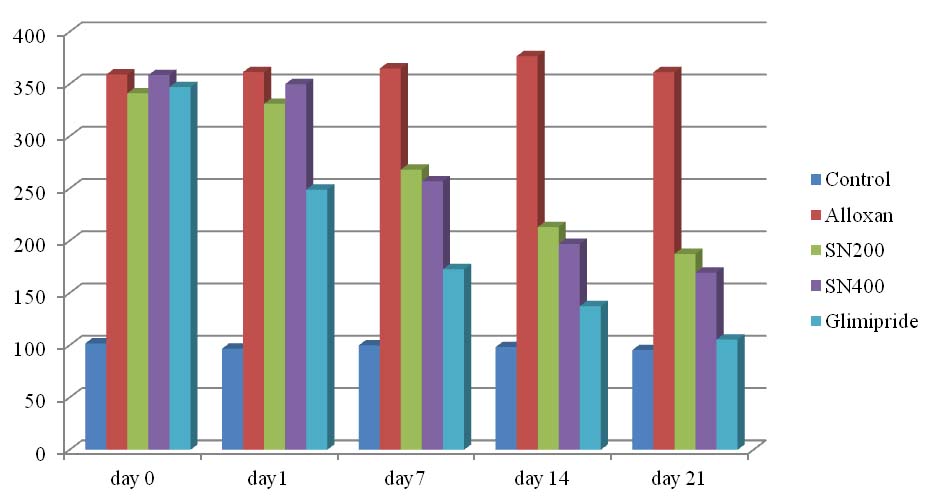
Comparison of fasting blood glucose level within and in between the groups.
| Groups | Drugs | Fasting Blood Glucose (mg/dl) |
|---|
| Day 0 | Day 1 | Day 7 | Day 14 | Day 21 |
|---|
| Group I | Control | 101.8 ± 3.4 | 96.8± 3.8 | 100± 3.5 | 98.3± 2.4 | 95.5± 3.1 |
| Group II | Alloxan | 359.2± 16.0 | 361.5± 17.1 | 365± 24.6 | 376.6± 6.1 | 361.3± 14.4 |
| Group III | SN200 | 341.2± 16.3 | 331.1± 12.2 | 268.2± 5.1** | 213.1± 9.2*** | 187.5± 3.6*** |
| Group IV | SN400 | 358.7± 7.9 | 350± 6.8 | 257± 5.2*** | 197± 8.2*** | 169.5± 7.3*** |
| Group V | Glimepride | 347.1± 10.1 | 249± 12.1*** | 172.8± 8.9*** | 137.5± 2.5*** | 105.5± 3.4*** |
Expressed as Mean ± SEM
* p<0.05, **p<0.01, ***p<0.001, SN= Solanum nigrum
Test drug AESNB in the dose of 200 mg/kg/day reduced the blood sugar level significantly on day 7 onwards (268.2±5.1 mg/dl, p<0.01). The fasting blood glucose level of AESNB 200 mg/kg/day was 213.1±9.2 mg/dl (p<0.001) on 14th day and 187.5±3.6 mg/dl on 21st day (p<0.001).
AESNB in the dose of 400 mg/kg/day reduced the blood glucose significantly on day 7 (257±5.2 mg/dl, p<0.001) onwards and 14th day fasting blood glucose level was 197±8.2 mg/dl (p<0.001), 21st day blood glucose level was 169.5±7.3 mg/dl (p<0.001). The test drug in both doses did not reduce the fasting blood glucose level to normal when compared to Group I.
Histopathological examination of pancreas: [Table/Fig-3] shows the normal pancreatic acini with normal cells of islets of Langerhans in normal animals (Group I). [Table/Fig-4] shows the damaged islets of Langerhans in Group II with irregular margins and with infiltration of inflammatory leucocytes. The number of islets of Langerhans was also reduced in Group II. [Table/Fig-5] shows the regenerating islets of Langerhans with infiltration of neutrophils in Group III. [Table/Fig-6] also shows the regenerating islets but with less inflammation compared to Group III. [Table/Fig-7] shows the fully regenerated islets of Langerhans without inflammation.
Pancreas of normal animals (Group I) (H&E-4X).
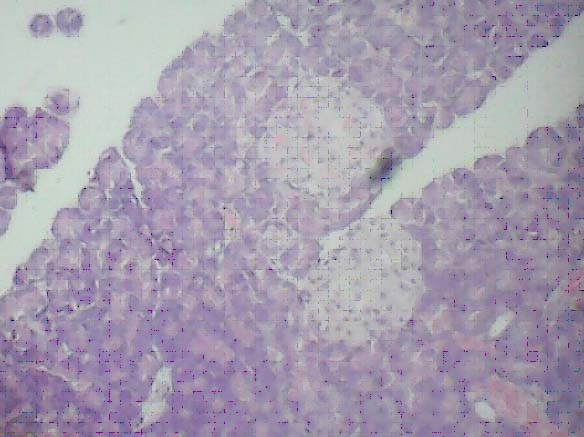
Pancreas of alloxan induced diabetic animals showing decreased number of islets with extensive areas of hyalinisation (Group II) (H&E-4X).
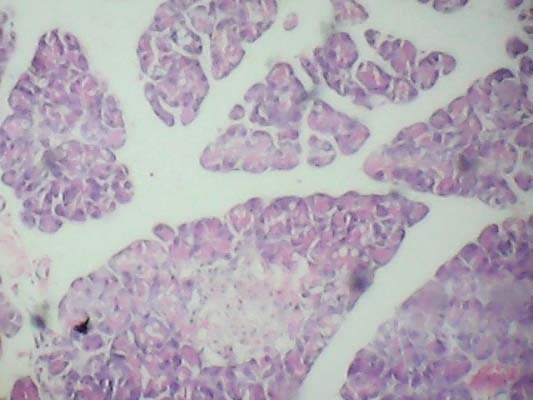
Pancreas of AESNB 200 mg/kg/day treated animals showing regenerating islets (Group III) (H&E-20X).
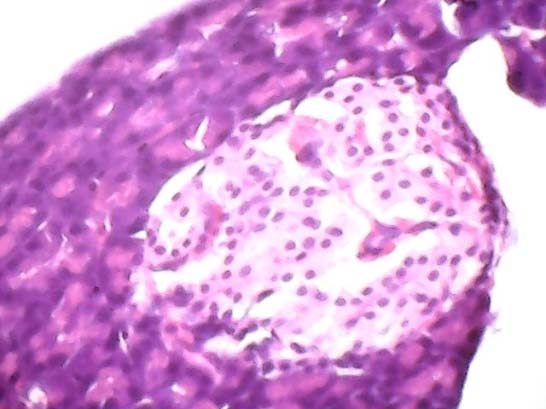
Pancreas of AESNB 400 mg/kg/day treated animals showing increased regenerative activity in islets (Group IV)(H&E-20X).
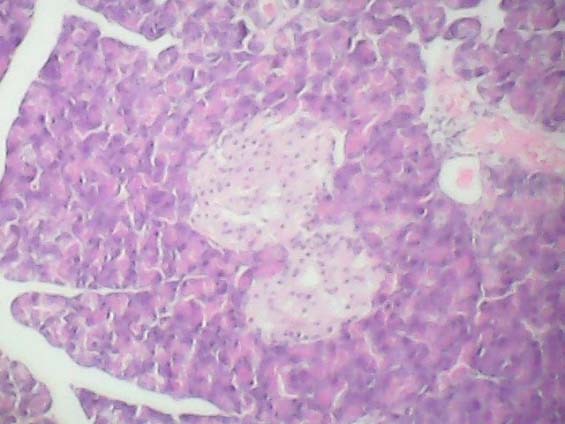
Pancreas of glimepride treated animals showing islets with mild inflammatory infiltrate (Group V) (H&E-20X).
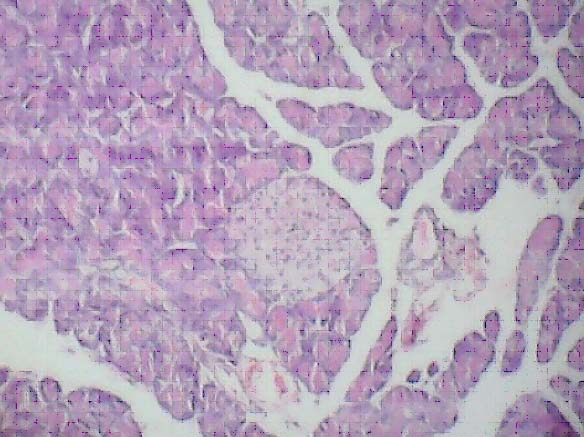
Discussion
The present study was designed to find out the phytochemical analysis and antidiabetic activity of aqueous extract of Solanum nigrum Linn berries. Phytochemical analysis showed the presence of flavonoids, alkaloids, saponins, tannins, glycosides, terpenoids, proteins, carbohydrates, acetic compounds and resin.
Phytochemical analysis of various parts of methanolic extract of Solanum nigrum Linn was analysed by Zemali D et al. They found that the methanolic extract of fruits contains large quantities of alkaloids and tannins and medium quantity of saponins, glycosides, coumarins, terpenoids, flavonoids but no volatile oil [13].
S. nigrum berries were extracted with various solvents and evaluated for phytochemical analysis, anti-inflammatory activity and anticonvulsant activity by Ravi V et al. On phytochemical analysis authors demonstrated the presence of carbohydrates, coumarins, phytosterols and flavonoids in ethanol and aqueous extracts. They also observed that the ethanolic extract had significant anti-inflammatory and anticonvulsant activity. They concluded that the anti-inflammatory and anticonvulsant activity might be due to the presence of flavonoids [14].
In the present study, the AESNB showed hypoglycaemic activity in a dose dependent manner. The AESNB in the dose of 200 mg/kg decreased the blood sugar level by 48% and AESNB in the dose of 400 mg/kg decreased the blood sugar by 53.18%. The standard drug glimepride decreased the blood glucose level by 70.9%. Reduction in the blood glucose level by AESNB is significant but not to the extent of the standard drug glimepride. Histopathological examination of the pancreas of Group III and Group IV showed less inflammation and more number of regenerating pancreatic islets of Langerhans compared to that of Group II but not to the extent of the standard drug glimepride (Group V).
Sathya Meonah ST et al., observed that aqueous extract of fruits of Solanum nigrum contains medium concentration of carbohydrates, iron and low concentration of alkaloids, phenolics and flavonoids. They also found out that aqueous extract of leaf and fruit has significant hypoglycaemic activity in a dose dependent manner than hydroalcoholic extracts and concluded that the presence of flavonoids in the extracts might be an active component responsible for the activity [15].
Shahla S et al., demonstrated the effect of aqueous extract of Solanum nigrum fruit on blood glucose, lipid profile and sensitivity of vascular mesenteric bed to phenylephrine in streptozotocin induced diabetic rats. Authors observed that administration of fruit extract improved Ca/Mg ratio, plasma glucose, high-density lipoproteins, normalized the low density lipoproteins, total cholesterol and triglyceride concentrations and also decreased alteration in vascular reactivity to vasoconstrictor agents. The decrease in blood glucose level was due to the ability of extract to repair the pancreatic beta cells or increase in Glu4 translocation [16].
In another study by the same authors, observed the effect of aqueous extract of Solanum nigrum fruit on vascular mesenteric beds in non-diabetic and Streptozotocin induced diabetic rats and found that low concentration of aqueous extract has higher vasodilatory effect in diabetic than non-diabetic mesentry bed vessel [17].
Dhirender K et al., demonstrated the analgesic, anti-inflammatory and antimicrobial activity of ethanolic extract of Solanum nigrum Linn fruits and concluded that the analgesic and anti-inflammatory activity of fruit extract was due to inhibition of various autacoids formation and release due to the glycoprotein which stimulates apoptosis via reduction of nitric oxide in HCT-116 cells and NO. It also has the most effective antimicrobial activity against Gram-positive organisms like S. aureus followed by B. subtilis. Against Gram-negative bacteria, it inhibits E. coli than P. aeruginosa. Ethanolic extract also has high activity against the fungus like Candida albicans. This antimicrobial activity might be due to the presence of steroidal alkaloid glycosides [18].
Various extracts of Solanum nigrum fruits also demonstrated its antiulcer, antioxidant and antitumour, antidiarrhoeal activity [19].
In the present study, antidiabetic activity of AESNB might be due release of insulin from pancreatic beta cell or reduction in Insulin resistance. This might be due to the presence of saponins [20].
The type II diabetes induced by alloxan is due to the oxidative stress [21] Antioxidants present in the AESNB may also be responsible for the antidiabetic activity due to modulation of various enzyme activities [22]. Flavonoids present in the AESNB also possess antioxidant activity [23].
Arulmozhi V et al., evaluated antioxidant and hyperlipidemic effect of Solanum nigrum fruit extract on chronic ethanol toxicity model in rats. They concluded that the protective effect was due to the presence of steroidal saponins called nigrumin I and II which possessed antioxidant and detoxifying effects [24,25].
Mirunalini S et al., stated that treatment with Solanum nigrum brought back the level of antioxidants like SOD, CAT, GPx and GSH to normal in liver of rats administered with ethanol [26].
Lin H et al., stated that the hepato-ameliorating and antioxidant effects of extract of S. nigrum fruit were better than extract of whole plant [27].
Histopathological features of the comparable regeneration of islets of Langerhans shown by aqueous extracts of Solanum nigrum berries shows the healing nature of AESNB, as a possible mechanism of their antidiabetic activity. The antidiabetic activity of AESNB might probably be due to the presence of bioactive principals like flavanoids, saponins and the antioxidant and anti-inflammatory properties of berries of Solanum nigrum. Further researches are needed to isolate and evaluate the active ingredient responsible for the action
Conclusion
This study found out that the long term administration of aqueous extract of Solanum nigrum Linn berries decreases the fasting blood glucose level. The antihyperglycaemic activity of the AESNB might be due to the presence of saponins and flavonoids.
Expressed as Mean ± SEM* p<0.05, **p<0.01, ***p<0.001, SN= Solanum nigrum